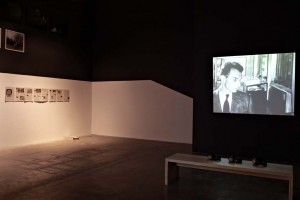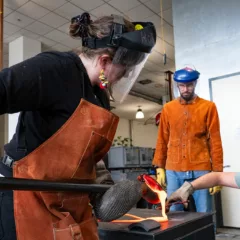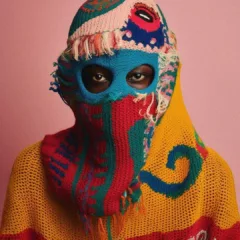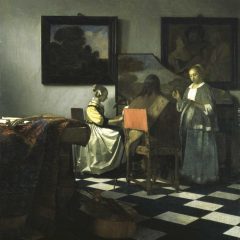The epitath for Clemens von Wedemeyer‘s The Fourth Wall, through Jan. 29, 2011 at Project Arts Centre, Dublin, might be Anthropologist, heed thyself. The three-channel installation, supported by a printed guide, explores story-telling, the search for human origins, the credibility of film, the responsibility of anthropology and our tendency to view the world through expectations honed by legend and desire. The video one sees on entering the gallery, Found Footage, centers on the first contact, in 1971, with the Tasaday, a tribal group in the Mindano rainforest of the Philippines. The tribe had been living a Stone Age existence in caves, untouched by the modern world. Or had they?
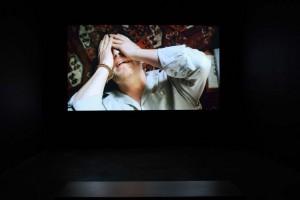
Fifteen years after their discovery a journalist returned to the location to find the caves empty and the Tasaday living nearby, in modern houses and dressed in blue jeans. Was this the rapid assimilation of modern life, or had the previous discovery been a hoax? We see 31 minutes of news clips of David Brinkley reporting on the controversy, anthropologists giving opposing opinions, and various Hollywood versions of tribal life, romances of a lost Eden. We inevitably re-view the images of first contact in light of the crude Hollywood versions. Can photography and film ever tell the truth, or does the very act of recording create distortion?
On the second screen, Interview depicts the talking head of Geoffrey Frand, described in the accompanying literature as lecturer, ethnographer, and actor; it is not at all obvious which guise we are seeing. In polished academic-speak he describes a talk he has just given to employees of a bank, for which he was very well-paid. The bank wanted him to shake up the thinking of the staff, using humanistic ideas to stimulate the business imagination. Frand tells us he discussed the responsibility of the anthropologist to his subjects; should we attempt contact with isolated groups, or preserve their isolation? What are the consequences for them? And for us? He tells of a colleague irreparably harmed by exposure to sacred tribal knowledge. Frand suggests that anthropologists contribute to the cultural contamination of isolated peoples – a questionable suggestion for 21st century anthropology, which, going beyond the essentialist myth of purity, often takes contamination as its subject.
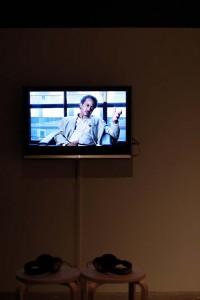
In addition to the guide, a tabloid-format First Contact; Film Material no. 4 is available in the exhibition space; it includes numerous short essays and further interviews. The first is with Ruggero Deodato who was inspired by a National Geographic article on the Tasaday to write and direct the film Cannibal Holocaust (1979), which became a cult classic. Twenty years later his film became the unacknowledged basis for The Blair Witch Project; his historical re-creation became the source for fiction and for his own acclaim within the film world. Another interview is with John Nance, the journalist who brought the Tasaday to the world’s attention. The subsequent controversy, which Nance describes as the real hoax, cost him his professional status. Nance continues to believe the story of the Tasaday.
Around the corner a third screen shows Against Death, a polished, continuously looping narrative shot on film and transferred to video. It is set in the high-rise apartment of an anthropologist (who appears to be Frand, again; the actor credited is Geoffrey Burton), from which we can see the cityscape of London at night. The flat is decorated with the spoils of his research: tribal weavings and ritual objects cover every available space. An explorer friend has returned from a visit with an isolated tribe in the jungle where he was exposed to esoteric knowledge which he claims will make him immortal. Here we recognize Frand’s cautionary tale. The explorer responds to the anthropologist’s skepticism by slitting his own throat; while he appears to expire, the story returns to the beginning where he is once again alive, made immortal by the film’s looping structure.
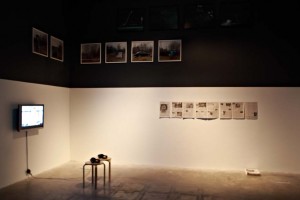
Von Wedemeyer’s compelling and carefully-constructed meditation on documentary teases us with enough obvious fiction, abundant printed source material and analysis, to force us to question the status of the previous footage. He convinces us that even if the original photographs of the Tasaday recorded the truth, they were inevitably colored by our long exposure to myths of uncontaminated humanity. Our origins are unknowable, but will forever be the focus of scientific and fictional expeditions. We want to believe.
The three-channel installation is the third part of The Repetition Festival Show, a survey of von Weidemeyer’s work in the form of four, sequentially-screened film and video installations, organized by Project Arts Centre with the Fondazione Galleria Civica, Trento. The other parts are Occupation and The Making of Occupation (2002), Otjesd (2005), and From the Opposite Side (2007) ; the first two have already been screened and the last will be seen in Dublin from Jan. 31-Feb. 19, 2011. The Repetition Festival Show will be screened at the Kunsthal Charlottenborg, Copenhagen from March 5 – May 22 and in Trento from May 28 to Aug. 28, 2011.


